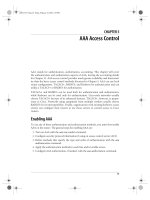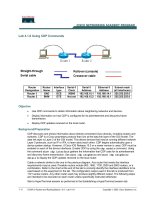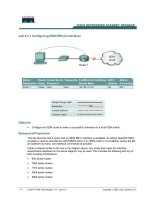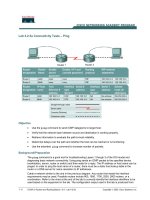Tài liệu Lesson 4: Control Statements - Loops ppt
Bạn đang xem bản rút gọn của tài liệu. Xem và tải ngay bản đầy đủ của tài liệu tại đây (48.02 KB, 6 trang )
Using Excellent Tools to Write Web Applications Targeting
the .NET Common Language Runtime (CLR)
[Home] [Up] [Lesson01] [Lesson02] [Lesson03] [Lesson04] [Lesson05
[Lesson06] [Lesson07] [Lesson08] [Lesson09] [Lesson10] [Lesson11
[Lesson12] [Lesson13]
On sale Now! C#
Unleashed is an in-
depth guide for
intermediate to
advanced software
developers to learn
the C#
programming
language and
serve as a desktop
reference.
.
.
.
.
.
.
.
.
.
.
The C# Station Tutorial
by Joe Mayo, 9/7/00
Lesson 4: Control Statements - Loops
This lesson teaches you how to use C# Selection Control Statements. More
specifically, the looping statements. It's goal is to meet the following
objectives:
l
Learn the "while" loop.
l
Learn the "do" loop.
l
Learn the "for" loop.
l
Learn the foreach loop.
l
Complete your knowledge of the "break" statement.
l
Teach you how to use the "continue" statement.
In the last lesson, you learned how to create a simple loop by using the
"goto" statement. I advised you that this is not the best way to perform
loops in C#. The information in this lesson will teach you the proper way
to execute iterative logic with the various C# looping statements.
Our first statement is the while loop.
Listing 4-1. The While Loop: WhileLoop.cs
using System;
class WhileLoop
{
public static void Main()
{
int myInt = 0;
while (myInt < 10)
{
Console.Write("{0} ", myInt);
myInt++;
}
Page 1 of 6Tutorial
6/24/2002 /> Console.WriteLine();
}
}
Listing 4-1 shows a simple while loop. It begins with the keyword "while",
followed by a boolean expression. All control statements use boolean
expressions. This means that the expression must evaluate to either a
true or false value. In this case we are checking the myInt variable to see
if it is less than (<) 10. Since myInt was initialized to 0, the boolean
expression will return true the first time it is evaluated. When the
boolean expression evaluates to true, the block immediately following the
boolean expression will be executed.
Within the while block we print the number and a space to the console.
Then we increment (++) myInt to the next integer. Once the statements
in the while block have executed, the boolean expression is evaluated
again. This sequence will continue until the boolean expression evaluates
to false. Once the boolean expression is evaluated as false, program
control will jump to the first statement following the while block. In this
case, we will write the numbers 0 through 9 to the console, exit the while
block, and print a new line to the console.
Similar to "while" loop is the "do" loop.
Listing 4-2. The Do Loop: DoLoop.cs
using System;
class DoLoop
{
public static void Main()
{
string myChoice;
do
{
// Print A Menu
Console.WriteLine("My Address Book\n");
Console.WriteLine("A - Add New Address");
Console.WriteLine("D - Delete Address");
Console.WriteLine("M - Modify Address");
Console.WriteLine("V - View Addresses");
Console.WriteLine("Q - Quit\n");
Console.WriteLine("Choice (A,D,M,V,or Q): ");
// Retrieve the user's choice
myChoice = Console.ReadLine();
// Make a decision based on the user's choice
switch(myChoice)
{
Page 2 of 6Tutorial
6/24/2002 /> case "A":
case "a":
Console.WriteLine("You wish to add an address.");
break;
case "D":
case "d":
Console.WriteLine("You wish to delete an address.");
break;
case "M":
case "m":
Console.WriteLine("You wish to modify an address.");
break;
case "V":
case "v":
Console.WriteLine("You wish to view the address list.");
break;
case "Q":
case "q":
Console.WriteLine("Bye.");
break;
default:
Console.WriteLine("{0} is not a valid choice", myChoice);
break;
}
// Pause to allow the user to see the results
Console.Write("Press any key to continue...");
Console.ReadLine();
Console.WriteLine();
} while (myChoice != "Q" && myChoice != "q"); // Keep going until the user
wants to quit
}
}
Listing 4-2 shows a "do" loop in action. The syntax of the "do" loop is "do
{ <statements> } while (<boolean expression>);". The statements can be
any valid C# programming statements you like. The boolean expression is
the same as all other's we've encountered so far. It returns either true or
false.
One reason you may want to use a "do" loop instead of a "while" loop is to
present a message or menu such as the one in Listing 4-2 and then retrieve
input from a user. Since the boolean expression is evaluated at the end of
the loop, the "do" loop guarantees that the statement's inside the loop will
execute at least 1 time. However, since a "while" loop evaluates it's
boolean expression at the beginning, there is generally no guarantee that
the statements inside the loop will be executed, unless you program it
explicitly to do so.
We'll do a quick review of Listing 4-2. In the Main() method, we declare
the variable "myChoice" of type string. Then we print a series of
statement to the console. This is a menu of choices for the user. We
must get input from the user, which is in the form of a Console.ReadLine()
method which returns the user's value into the myChoice variable. We
Page 3 of 6Tutorial
6/24/2002 />must take the user's input and process it. A very efficient way to do this is
with a "switch" statement. Notice that we've placed matching upper and
lower case letters together to obtain the same functionality. This is the
only legal way to have automatic fall through between cases. If you were
to place any statements between two cases, you would not be able to fall
through. Another point is that we used the "default:" case - a very good
habit to make.
Listing 4-3. The For Loop: ForLoop.cs
using System;
class ForLoop
{
public static void Main()
{
for (int i=0; i < 20; i++)
{
if (i == 10)
break;
if (i % 2 == 0)
continue;
Console.Write("{0} ", i);
}
Console.WriteLine();
}
}
Listing 4-3 shows the "for" loop. For loops are good for when you know
exactly how many times you want to perform the statements within the
loop. This listing produces the same results as the "while" loop in Listing
4-1. The contents within the "for" loop parenthesis holds three sections
separated by semicolons "(<initializer list>; <boolean expression>; <post-
loop action list>)".
The initializer list is a comma separated list of expressions. These
expressions are evaluated only once during the lifetime of the "for" loop.
This is in the beginning, before loop execution. As shown in Listing 4-3,
this section is commonly used to initialize an integer to be used as a
counter.
Once the initializer list has been evaluated, the "for" loop gives control to
its second section, the boolean expression. There is only one boolean
expression, but it can be as complicated as you like as long as the result is
true or false. The boolean expression is commonly used to verify the
status of a counter variable.
When the boolean expression evaluates to true, the statements within the
curly braces of the "for" loop are executed. Normally, these statements
Page 4 of 6Tutorial
6/24/2002 />execute from the opening curly brace to the closing curly brace without
interruption. However, in Listing 4-3, we've made a couple exceptions.
We have a couple "if" statements that disrupt the flow of control within
the "for" block.
The first "if" statement checks to see if "i" is equal to 10. Now you see
another use of the "break" statement. It's behavior is similar to the
selection statements. It simply breaks out of the loop at that point and
transfers control to the first statement following the end of the "for"
block.
The second "if" statement uses the remainder operator to see if "i" is a
multiple of 2. This will evaluate to true when "i" is divided by 2 with a
remainder equal to zero, (0). When true, the "continue" statement is
executed. Control will skip over the remaining statements in the loop and
transfer back to the post-loop action list. By arranging the statements
within a block properly, you can conditionally execute them based upon
whatever condition you need.
When program control encounters either a continue statement or end of
block, right curly brace, it transfers to the third section within the "for"
loop parentheses, the post-loop action list. This is a comma separated list
of actions you would like to see occur after the statements in the "for"
block have been executed. Listing 4-3 is a typical action, incrementing
the counter. Once this is complete, control transfers to the boolean
expression for evaluation. The loop will continue as long as the boolean
expression is true. When the boolean expression becomes false, control is
transferred to the first statement following the "for" block.
Listing 4-4. The ForEach Loop: ForEachLoop.cs
using System;
class ForEachLoop
{
public static void Main()
{
string [] names = {"Cheryl", "Joe", "Matt", "Robert"};
foreach (string person in names)
{
Console.WriteLine("{0} ", person);
}
}
}
The "foreach" loop allows you to iterate through a collection. An array, as
used in Listing 4-4, is one such collection (there are others in
"System.Collections"). The first thing we've done inside the Main() method
is declare and initialize the "names" array with 4 strings.
Page 5 of 6Tutorial
6/24/2002 />









